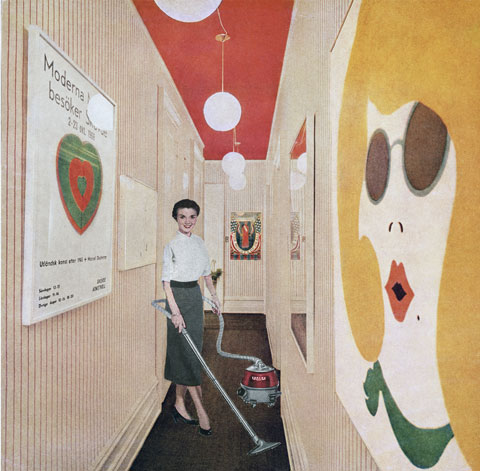
WOMAN VACUUMING (VACUUMING POP ART) Is it a surprise that women like Martha Rosler were left out of an art movement that reflected the imagery of Madison Avenue and Hollywood? |
"I was just compulsively doing these things when my son went to sleep," Martha Rosler recalls of her 1960s collages of photos and magazine clippings. "Having a child meant that you were not a serious person. It meant that you were willing to give up studio time for nappy time."
Rosler's work was some of the fiercest art to come out of the '60s. In "Seductive Subversion: Women Pop Artists 1958-1968" at Tufts University Art Gallery, her collage Makeup/Hands Up replaces the eye of a woman putting on eye shadow with an image of a black American soldier menacing a Vietnamese girl. Woman Vacuuming depicts a woman smiling perkily as she vacuums a hall lined with Pop art. It's an acid joke about how gender relegated Rosler and many women artists to cameo roles in the history of Pop — if they got any roles at all.
Women were doubly outsiders to Pop — first because of their gender, and second because Pop was defined as uncritically, apolitically adopting the slick, mechanical imagery of Madison Avenue and Hollywood.
This exhilarating — and frustrating — exhibit, which was organized by Sid Sachs for the University of the Arts in Philadelphia, aims to right that wrong by showcasing 23 women who got overshadowed by male peers like Andy Warhol and Roy Lichtenstein. The art is exhilarating, if mixed, featuring a handful of familiar if infrequently seen faces among work that will be new to most viewers.
>>SLIDESHOW: 'Seductive Subversion' at Tufts, '24/7' at DeCordova <<
Marjorie Strider's 1963 painting Triptych II (Beach Girl) presents three images of the same bikini babe rendered with catchy cartoon flatness on a silver background, except for the woman's breasts, which Strider made 3D with wood. She meant this as a satire of girlie magazines, but it reads as one more sexually available model. Matters get more pointed with Jann Haworth (who with her artist husband, Peter Blake, designed the cover of the Beatles' Sgt. Pepper's Lonely Hearts Club Band). Her life-size fabric sculpture of a French maid seated on a sofa in black mini-dress, heels, and lacy heart-shaped apron is creepy and confrontational; it feels like a mix between a sex doll and a corpse. Dorothy Iannone offers perhaps the only instance in the show of passionate female sexual desire with her 1969-'70 painting I Love To Beat You, a visionary psychedelic graphic image of a man with his head buried in a naked lady's crotch.
Other artists reflect movies or contemporary style. Rosalyn Drexler divides her canvases into images of clumsily painted gangsters or flat rectangles of color recalling filmstrips or Barnett Newman. A 1963 Marisol sculpture shows a gunslinging John Wayne, built from stacked wood boxes, riding an anatomically correct plywood merry-go-round stallion. Idelle Weber's strikingly designed painting Munchkins I, II and III depicts suited men in black silhouette riding escalators against a yellow-and-black checkerboard background.